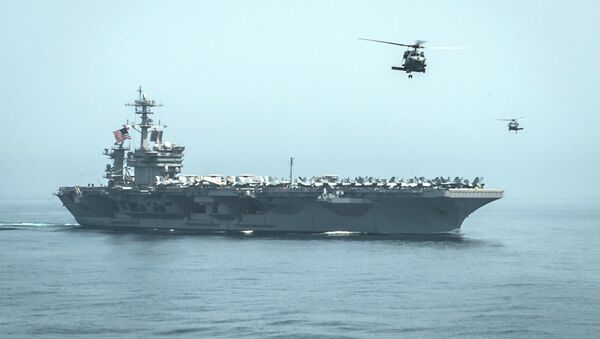Tehran has always been prepared for a full-fledged war, Iran's Revolutionary Guards Corps Aerospace Force Chief Amirali Hajizadeh said in a statement on Sunday, just a day after two drone attacks on oilfields in Saudi Arabia, which were claimed by Houthis and blamed by the US and Saudi Arabia on Tehran.
“Everybody should know that all American bases and their aircraft carriers, at a distance of up to 2,000 kilometres around Iran, are within the range of our missiles,” Hajizadeh said.
According to Hajizadeh, the Iranian military are ready to target two US bases and one carrier in the event of an armed conflict.
"Al-Udeid base in Qatar, az-Zafra base in the UAE and a US vessel in the Gulf of Oman would be targeted if Washington took military action," the commander said.
Global Community Condemns Drone Attacks on Saudi Arabia
Saturday's drone attacks on Saudi Aramco factories prompted the United States to accuse Iran of being behind the incident.
US Senator Lindsey Graham accused the Islamic Republic of looking to “wreak havoc in the Middle East”, and recommend that the US “put on the table an attack on Iranian oil refineries if they continue their provocations”.
Moreover, US Secretary of State Mike Pompeo pinned the blame on Tehran over the attacks calling for public condemnation of Iran's actions.
Reacting to the accusations, the Iranian Foreign Ministry's spokesman Abbas Mousavi has condemned Mike Pompeo's recent statement on Iran's involvement in the drones attack against Saudi Aramco oil facilities in the kingdom, calling them a lie.
"The US policy of exerting "maximum pressure", that apparently failed, veered towards "maximum lie" policy," Mousavi said.
In the meantime, Saudi Crown Prince Mohammed bin Salman told Trump during the phone call that the kingdom was willing and able to confront and deal with this "terrorist aggression."
Meanwhile, the French Foreign Ministry also decried the attacks on Saudi oil facilities, expressing "full solidarity" with Riyadh.
"These actions can only worsen regional tensions and risk of conflict," the ministry said. "It is imperative that they stop."
Drone Attacks on Saudi Oilfields
On Saturday, two drone attacks, claimed by Houthis, caused major fires in two oil facilities: in Abqaiq in eastern Saudia Arabia and Khurais northeast of Riyadh. These were eventually contained by security and emergency service personnel. According to the Saudi energy minister, Prince Abdulaziz bin Salman, oil production at the two plants has temporarily stopped, interrupting about half of the company's total daily oil output.
Yemen's Houthi movement has been launching drone attacks against Saudi Arabia's infrastructure and military facilities in response to the Saudi-led military campaign in Yemen, which began in March 2015, aiming to restore the government of President Abdrabbuh Mansour Hadi.
Both Riyadh and Washington claimed that Houthis have been receiving Iranian military assistance. Tehran has repeatedly rejected these allegations, citing the naval blockade which has been in place against the southern Arabian country since 2015.
Tensions in the Gulf
Tensions have been running high in the Persian Gulf since the Trump administration withdrew last year from the Iran nuclear deal, and then hit Iranian industries with new sanctions, prompting Tehran to take advantage of treaty backstops to increase its supply of low-enriched uranium.
The situation came to a boiling point this year after alleged attacks on two US oil tankers in the vicinity of the Strait of Hormuz in June. Washington accused Iran of the incident, while Tehran vehemently denied its involvement. A week later, a US drone was downed by Tehran; Iran insisted that the aircraft violated its airspace, prompting Washington to introduce sanctions against the nation's Supreme Leader Ali Khamenei.
The situation further exacerbated after Adrian Darya 1 tanker, formerly known as Grace 1 was detained off Gibraltar. It was released on 15 August after it had been held for a month. A Gibraltar court ordered the release of the ship despite a last-minute request by the US to extend its detention in view of differences in US and European sanctions against Iran.
Amid the arrest of Darya 1, Iranian authorities detained oil tanker Stena Impero on 19 July over alleged maritime violations. Tehran stressed that the arrest was not retaliation for the seizure of Iranian oil tanker Grace 1 by UK overseas territory Gibraltar earlier the same month.


